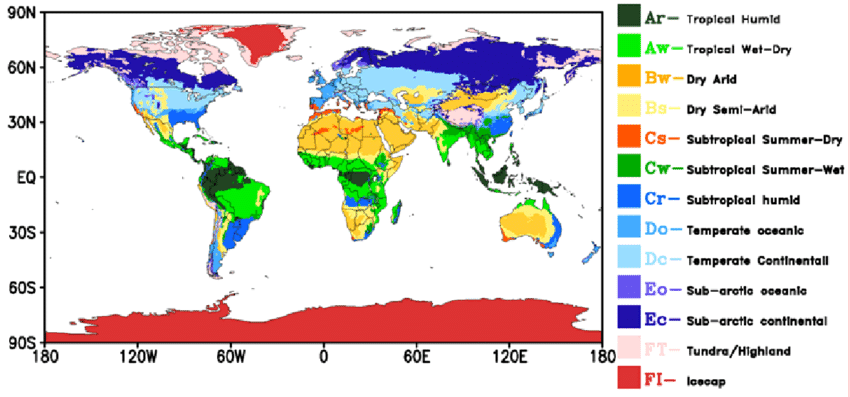W.B.C.S. Examination Notes On – Climatic Classification – Geography Notes.
The earliest known classification of climate, devised by the Greeks, simply divided each hemisphere into a mathematical climate of three zones, the “summerless,” “intermediate,” and “winterless,” thus accounting only for the latitudinal differences in solar effect (the Greek word klima means “inclination”).Continue Reading W.B.C.S. Examination Notes On – Climatic Classification – Geography Notes.
More recently, these zones have been labeled the Torrid, Temperate, and Frigid Zones. Apparently, the first major improvement over this classification was introduced by Alexander Supan in the nineteenth century. He based his zones on actual rather than theoretical temperatures, and named one hot belt, two temperate belts, and two cold caps. Supan also divided the world into 34 climatic provinces, with no attempt to relate similar climates of different locations. Another basic and much used approach recognizes other climatic controls as well as the sun.
As noted above, temperature defines the other four major climate types. These are subdivided, with additional letters again used to designate the various subtypes. Type A climates (the warmest) are differentiated on the basis of the seasonality of precipitation: Af (no dry season), Am (short dry season), or Aw (winter dry season). Type E climates (the coldest) are conventionally separated into tundra (ET) and snow/ice climates (EF). The mid-latitude C and D climates are given a second letter, f (no dry season), w (winter dry), or s (summer dry), and a third symbol (a, b, c, or d [the last subclass exists only for D climates]), indicating the warmth of the summer or the coldness of the winter. Although Köppen’s classification did not consider the uniqueness of highland climate regions, the highland climate category, or H climate, is sometimes added to climate classification systems to account for elevations above 1,500 metres (about 4,900 feet).
The resulting climates are called (with variations) polar, temperate, tropical, continental, marine, mountain, and probably others. Of the major climatic classifications in use today, those of W. Köppen (1918) and C. W. Thornthwaite (1931) are referred to most often. Köppen’s elaborate “geographical system of climates” is based upon annual and seasonal temperature and precipitation values; his climatic regions are given a letter code designation. The major categories are tropical rainy climate, dry climate, temperate rainy climate, snow forest climate, tundra climate, and perpetual frost climate. Gorczyński (1948) devised a decimal number system similar to the Köppen classification. Thornthwaite’s (1931) bioclimatological system utilizes indices of precipitation effectiveness to outline humidity provinces, and thermal efficiency for temperature provinces; and again, a letter code designates regions.
Thornthwaite (1948) introduced an approach to a “rational” classification, wherein potential evapotranspiration is used as a measure of thermal efficiency, and is compared to precipitation to form a moisture index and to show amounts and periods of water surplus and deficiency. Definite break points are revealed that are adaptable as climatic boundaries. Many authors have devised modified classifications to instruct a particular audience. An excellent example is that of C. E. P. Brooks (1951) in which climatic regions are defined with respect to human activity.
Please subscribe here to get all future updates on this post/page/category/website


 Toll Free 1800 572 9282
Toll Free 1800 572 9282  mailus@wbcsmadeeasy.in
mailus@wbcsmadeeasy.in



















































































































